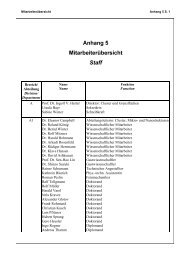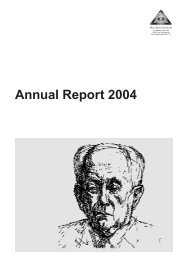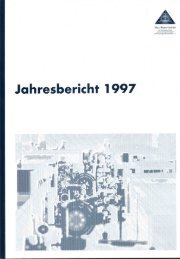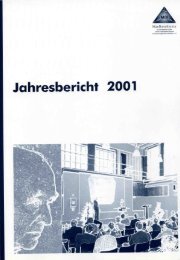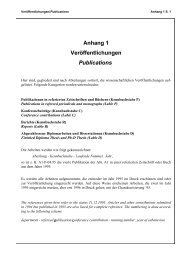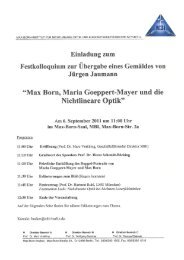Create successful ePaper yourself
Turn your PDF publications into a flip-book with our unique Google optimized e-Paper software.
Fig. 11<br />
A sketch of the idea behind<br />
making single attosecond<br />
pulses.<br />
42<br />
Attosecond Imaging –<br />
seeing electrons move:<br />
<strong>Max</strong> <strong>Born</strong> • Paul Corkum<br />
Fig. 12<br />
A sketch of the optical<br />
parts of the experimental set-up for<br />
the tomography measurements.<br />
Figure 14 shows that we measured the relative phase of the electron orbital correctly and that<br />
we correctly found the position of the nodes of the wave function. However the orbital is too<br />
large at its extremes. The small errors that remain are probably due to the relatively low energy<br />
of our re-collision electron. Had we used a laser beam shifted further into the infrared, then<br />
our cut-off harmonics would have been higher and our spatial resolution better.<br />
When a molecule’s atoms move during a chemical reaction, they carry their electrons with them.<br />
Our technology is fast enough to image this motion. This would fulfill the dream of truly imaging<br />
chemical reactions as they occur. As we extend the technology to more complex molecules and<br />
molecules undergoing dynamics, we will obtain images of chemistry reactions-in-progress that<br />
will as dramatic as Muybridge’s images of trotting horses taken more than 125 years ago.<br />
But the technology promises more – it is capable of attosecond time resolution. Of course, for<br />
attosecond imaging to be worthwhile, there must be interesting things happening on this time<br />
scale to observe. Attoseconds are the time scale for electron motion. A classical electron completes<br />
a Bohr orbit in about 150 attoseconds. Although quantum mechanics says that the Bohr<br />
orbit is not observable, it does allow us to observe something comparable. As we have seen,<br />
quantum mechanics allows us to split an electron. If we split it so that it occupies two or more<br />
orbitals simultaneously, then the interference between these parts of the electron wave function<br />
look very much like an orbiting electron (i.e., like Bohr orbit motion). This classical-like motion<br />
is another example of a wave packet – a term I have already introduced to you when describing<br />
the motion of the electron that escapes the atom and then re-collides. I now show one<br />
way to measure this bound-state electron wave packet – with attosecond precision.<br />
Figure 15 illustrates the idea [14]. This time we split the electron twice. First, we split it to make<br />
the bound-state wave packet. Such wave packets require population in two or more orbits.<br />
These interfere with each other just as our re-collision electron interferes with its parent orbital,<br />
with their interference corresponding to the attosecond motion that we wish to measure.<br />
(This first splitting can occur naturally during the process that we want to study, or we can stimulate<br />
its occurrence with resonant light.)<br />
We then split the electron a second time. This time we use an intense light pulse just as we<br />
described in the earlier sections of the paper. Almost certainly it is the upper state that ionizes,<br />
since it is less strongly held by the ion. When the electron wave packet re-collides, it interferes<br />
with both bound parts of the previously split electron. Both contribute to the short wavelength<br />
light that is emitted. They “write” their joint signature on the light that the atom emits. Figure<br />
16 is a plot of the theoretical prediction of the light intensity emitted by a single atom. On the<br />
horizontal axis is the photon energy in electron volts. The vertical axis is a measure of the



